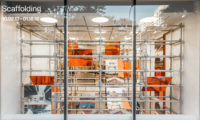Why Yugoslavia? It’s a question one can’t help but ask, given the circumstances. Martino Stierli, the new chief curator of architecture and design at the Museum of Modern Art, chose for his first major exhibition at the New York institution to focus on the built environment of the former Balkan nation, forever imprinted on the collective consciousness for the ethnic war that raged there for over a decade at the close of the last century.
Even before that, it was not exactly known as a hotbed of design. With the exception of Jože Plečnik, whose conical 1947 design for the Slovenian Parliament in Ljubljana is on display (but who is mainly included for his influence on later generations), most of the names in Toward a Concrete Utopia: Architecture in Yugoslavia, 1948–1980 are unfamiliar. “It is part of the job of the museum to critically reassess the canon of architectural history and look at parts of the world not seen as they should have been seen,” explains Stierli.
Indeed, the biggest strength of the exhibition is the abundance of beautifully hung and arranged drawings, photographs, and models of striking, and in some cases downright bizarre, buildings and monuments that most visitors have probably never seen before. It is astonishing also that much of this material, particularly the archival drawings, survived the ethnic war.
But while what’s on display may be completely new to most eyes, it’s not exactly groundbreaking. MoMA’s 2015 exhibition, Latin America in Construction: Architecture 1955–1980, with which this show will inevitably draw comparisons, presented an architecture that, despite being more familiar to viewers, is exciting and utterly unique to its region. The theory posited here is that Yugoslavia produced a distinct architecture because of its ethnic diversity, break with the Soviet bloc in 1948, and socialist agenda, but aside from the experimental and multitudinous monuments, some of which anticipated the Earth Art movement, what we see resembles much of what was built in Europe at the time.
For a nation that was also perceived to be behind the Iron Curtain throughout the period this exhibition covers, the displays, chiefly the specially commissioned photos of buildings now worn by age or from the war, do little to counter the notion of it as a gloomy place. The curators, who with Stierli include architectural historian Vladimir Kulić, seemingly aware of this danger, added pops of color where they could, including a slide show of Croatian resort hotels from the 1960s and ’70s populated by bikini-clad guests.
There is, at the end of it all, an unsettling irony to this exhibition. Stierli rightly placed this architecture “on equal par with anything built in post–World War II Europe.” But the architecture—much like the installation itself, well done though it is—is just not inventive or surprising enough. The exhibition, on view until January 13, 2019, introduces the work to a wider audience, but whether it will extend the influence of the region’s architecture beyond its own now completely altered borders remains a question.











Post a comment to this article
Report Abusive Comment